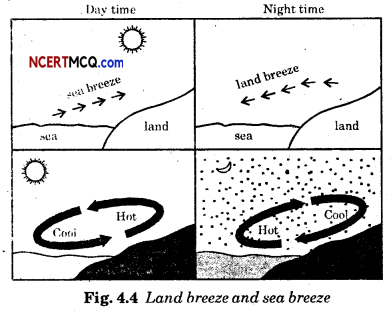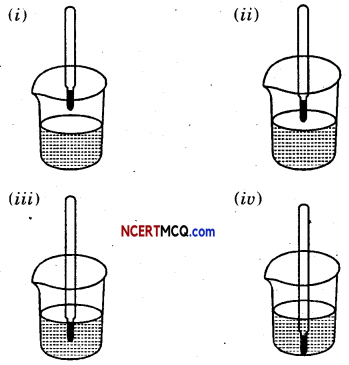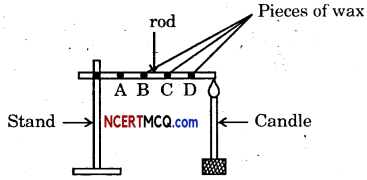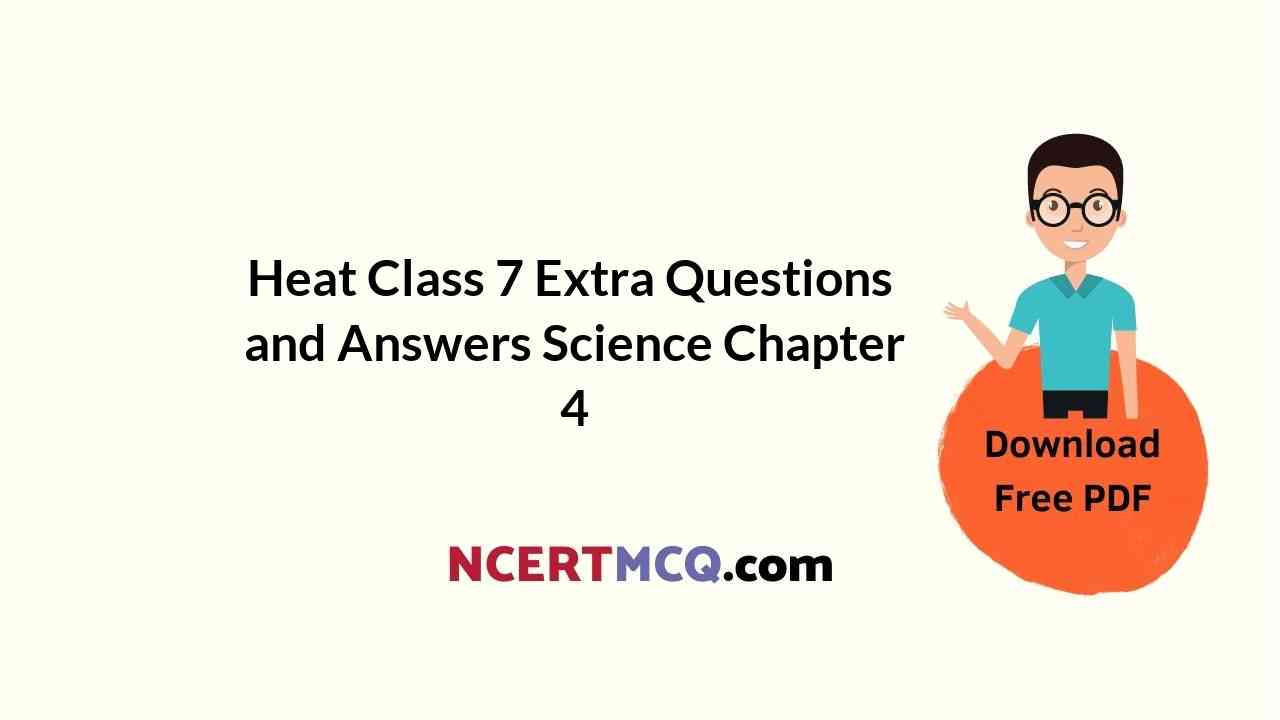Here we are providing Online Education for Heat Class 7 Extra Questions and Answers Science Chapter 4 was designed by subject expert teachers. https://ncertmcq.com/extra-questions-for-class-7-science/
Online Education for Class 7 Science Chapter 4 Extra Questions and Answers Heat
Class 7 Science Chapter 4 Heat Extra Questions Question 1.
What is a clinical thermometer?
Answer:
The thermometer that is used to measure human body temperature is called a clinical thermometer.
Class 7 Science Chapter 4 Extra Questions Question 2.
How is degree Celsius denoted?
Answer:
°C.
Heat Class 7 Extra Questions And Answers Question 3.
What is the range of a clinical thermometer?
Answer:
35°C to 42°C.
Heat Chapter Class 7 Pdf Questions And Answers Question 4.
What is the normal temperature of human body?
Answer:
The normal temperature of human body is 37°C.
![]()
Class 7 Heat Extra Questions Question 5.
Which gets hotter soon, land or water?
Answer:
Land.
Heat And Temperature Class 7 Questions And Answers Question 6.
Why is range of a clinical thermometer is chosen to be 35°C to 42°C?
Answer:
The clinical thermometer is designed to measure the temperature of human body only. The temperature of human body normally does not go below 35°C or above 42 GC. That is why the clinical thermometer has the range 35°C to 42°C.
Heat Class 7 Questions And Answers Question 7.
What caution do you suggest regarding a clinical thermometer?
Answer:
A clinical thermometer should not be used for measuring the temperature of any object other than the human body. Also, avoid keeping the thermometer in the sun or near a flame. It may break.
Class 7 Science Chapter 4 Extra Questions And Answers Question 8.
Why should you wear white clothes in summer and black clothes in winter?
Answer:
Dark surfaces absorb more heat and, therefore, we feel comfortable with dark-coloured clothes in the winter. Light coloured clothes reflect most of the heat that falls on them and, therefore, we feel more comfortable wearing them in the summer.
Heat Extra Questions Class 7 Question 9.
Describe the construction of a clinical thermometer.
Answer:
A clinical thermometer consists of a long, narrow, uniform glass tube. It has a bulb at one end. This bulb contains mercury. Outside the bulb, a small shining thread of mercury can be seen. There is also a Celsius scale on the thermometer.
Ncert Class 7 Science Chapter 4 Extra Questions Question 10.
How do land and sea breezes blow?
Answer:
During the day, the land gets heated faster than the water. The air over the land becomes hotter and rises up. The cooler air from the sea rushes in towards the land to take its place. The air forms the sea breeze. The warm air from the land moves towards the sea to complete the cycle.
At night it is exactly the reverse. The water cools down more slowly than the land. So, the cool air from the land moves towards the sea. This forms the land breeze.
![]()
Heat Chapter Class 7 Questions And Answers Question 11.
Show the formation of land and sea breezes with the help of diagrams.
Answer:

Class 7 Science Chapter 4 Extra Question Answer Question 12.
Boojho says, “My left hand tells me that the water in mug C is hot and the right-hand tells mc that the same water is cold. What should I conclude ?“
Answer:
Both conclusions are true relative to each hand. But a single conclusion cannot be drawn from the given information. This is all due to relative temperature.
Class 7 Science Ch 4 Extra Questions Question 13.
Boojho got a naughty idea. He wanted to measure the temperature of hot milk using a clinical thermometer. Paheli stopped him from doing so. Why?
Answer:
The clinical thermometer is designed to measure the human body temperature which ranges from 35CC to 42°C. Hot milk has a temperature range of 80°C to 100°C, which is quite high. This may break the thermometer because of abrupt mercury rise.
Ncert Solutions For Class 7 Science Chapter 4 Heat Extra Questions Question 14.
Boojho wonders why the level of mercury should change at all when the bulb of the thermometer is brought in contact with another object?
Answer:
The temperature of other objects may not be the same as that of the bulb of the thermometer. When bulb is brought in contact with that object, the temperature of the bulls changes. So the level of mercury also changes.
Questions On Heat For Class 7 Question 15.
Can you lift a hot pan by holding it from the handle without getting hurt?
Answer:
Yes. If the handle is insulated with the help of a cloth or insulated material like plastic or wood, the pan can be lifted without getting hurt.
Class 7 Science Heat Extra Questions Question 16.
Do these activities suggest to you the reason why it more comfortable to wear white or light-coloured clothes in the summer and dark-coloured clothes in the winter?
Answer:
Dark surfaces absorb more heat and, therefore, we feel comfortable with dark coloured clothes in the winter. Light coloured clothes reflect most of the heat that falls on them and, therefore, we feel more comfortable wearing them in the summer.
Question 17.
Suppose you are given the choice in winter of using one thick blanket or two thin blankets joined together. What would
you choose and why?
Answer:
I would choose two thin bi anklets joined together. This is because there would be a layer of air in between the blankets. The trapped air, which is a bad conductor of heat, keeps it warmer.
![]()
Question 18.
State similarities and differences between the laboratory thermometer and the clinical thermometer.
Answer:
Similarities:
(i) Both use mercury
(ii) Both measure temperature.
Differences :
(i) The temperature on laboratory thermometer falls by itself, but it does not happen in clinical thermometer.
(ii) The range of laboratory thermometers is much higher than clinical thermometers.
Multiple Choice Questions
1. Two large mugs are taken. These are labelled as A and B. Some hot water is put in mug A while some cold water is put in mug B. A boy dips his left hand in mug A and right hand in mug B. Now he interchanges i.e. he dips his right hand in mug A and left hand in mug B. Then :
(i) the water in the mug A will be felt hotter than before.
(ii) the water in the mug A will be felt colder than before.
(iii) the water in the mug B will be felt hotter than before.
(iv) in both the cases the temperature of water in mug ’A will be felt the same.
Answer:
(i) the water in the mug A will be felt hotter than before.
2. In the above experiment, the boy felt the water hot when he dips his hand in mug A. It is because :
(i) the temperature of the water was less than the temperature of his body.
(ii) the temperature of the water was more than the temperature of his body.
(iii) the temperature of the water was less than the temperature of the surroundings.
(iv) the temperature of the water was equal to the temperature of the surroundings.
Answer:
(ii) the temperature of the water was more than the temperature of his body.
3. Before using the thermometer, it is ensured that the level of mercury is below :
(i) 33°C
(ii) 34°C
(iii) 35°C
(iv) 36°C.
Answer:
(iii) 35°C.
![]()
4. The normal temperature of human body is :
(i) 35°C
(ii) 37°C
(iii) 36°C
(iv)38°C.
Answer:
(ii) 37°C.
5. To measure the temperature of his body, a boy performed the following steps :
(A) Washed the thermometer.
(B) Checked out whether the mercury level was below 35°C.
(C) Hold it firmly and gave few jerks so that the level of mercury fall down below 35°C.
(D) Placed the bulb of the thermometer below the tongue for five minutes.
(E) Took out the thermometer, and checked out the body temperature.
Answer:
(D) Placed the bulb of the thermometer below the tongue for five minutes.
Which of the above-mentioned step is wrong?
(i) A
(ii) B
(iii) C
(iv) D
Answer:
(iv) D.
6. The temperature of human body does not go above:
(i) 40°C
(ii) 38°C
(iii) 42°C
(iv) 44°C.
Answer:
(iii) 42°C.
7. The temperature range of a typical clinical thermometer is usually between :
(i) 32°C to 35°C
(ii) 34°C to 38°C
(iii) 35°C to 40°C
(iv) 35°C to 42°C.
Answer:
(iv) 35°C to 42°C.
![]()
8. The range of a laboratory thermometer is generally in between :
(i) – 20°C to 120°C
(ii) – 20°C to 110°C
(iii) – 10°C to 120°C
(iv) – 10°C to 110°C
Answer:
(iv) – 10°C to 110°C.
Q. 9. Which of the following pictures best describes the method of measuring temperature of water with a laboratory thermometer?
Answer:

10. What is the use of kink in a thermometer?
(i) It helps in measuring the temperature.
(ii) It prevents mercury level from falling on its own.
(iii) It stores mercury.
(iv)it controls the temperature.
Answer:
(ii) It prevents mercury level from falling on its own.
12. In solid, generally heat is transferred by the process of :
(i) conduction
(ii) convection
(iii) radiation
(iv) transmission.
Answer:
(i) conduction.
13. An iron rod is taken. Four pieces of wax say A, B, C and D are fixed on the rod from one end – all at equal distance to
one another. The rod is clamped to a stand. Now the other end of the rod is heated. Which piece of wax will fall first?

(i) A
(ii) B
(iii) C
(iv) D.
Answer:
(iv) D.
14. Which of the following substances is a conductor of heat?
(i) Plastic
(ii) Aluminium
(iii) Wood
(iv) Plywood.
Answer:
(ii) Aluminium.
15. Which of the following substances is an insulator of heat?
(i) Iron
(ii) Copper
(iii) Rubber
(iv) Bronze.
Answer:
(iii) Rubber.
![]()
16. Heat travels of:
(i) conduction
(ii) convection
(iii) radiation
(iv) insulation.
Answer:
(ii) convection.
17. When the air gets heated by convection :
(i) it rises upwards.
(ii) it moves sideways.
(iii) it rises upwards as well as mdves sideways.
(iv) it goes downwards.
Answer:
(i) it rises upwards.
18. In coastal area, land breeze blows during
(i) day
(ii) night
(iii) afternoon
(iv) both day and night .
Answer:
(ii) night.
19. Heat reaches to the earth from the sun by the process of :
(i) conduction
(ii) convection
(iii) radiation
(iv) insulation.
Answer:
(iii) radiation.
20. Which of the following surfaces is a good absorber of heat?
(i) Black
(ii) White
(iii) Shiny
(iv) Bright
Answer:
(i) Black.
21. Which of the following statements is true?
(i) All hot bodies radiate heat.
(ii) All hot bodies do not radiate heat.
(iii) Some hot bodies radiate heat while others do not.
(iv) Only black bodies radiate heat.
Answer:
(i) All hot bodies radiate heat.
Keywords:
→ Celsius scale: The temperature scale which defines the temperature of boiling water is 100 degrees and that of freezing water as 0 (zero) degrees.
→ Conduction: The process by which heat is transferred from the hotter end to the colder end of an object is known as conduction.
→ Conductor: The materials with allow neat to pass through them easily is called conductor of heat.
→ Convection: The process of transfer of he’ the molecules of a fluid from hot rear. to, cok vision called convection.
→ Insulators: A poor conductor is known as insulator.
→ Land breeze: The air from the land that moves towards the sea is called the land breeze,
→ Radiation: The process by which heat is transferred from one place to another without any medium is called radiation.
→ Sea breeze: The air that comes from the sea is called the sea breeze.
→ Temperature: A measure of the hotness of an object is its temperature.
→ Thermometer: The device by which temperature is measured is called thermometer.
